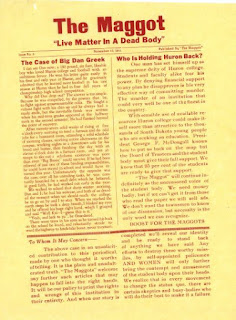It was in the early 1880s when Albert
Lampe Sr, along with his wife and five children made the long and difficult trip
from Wernigerode, Germany to Huron, South Dakota. Lampe's family had
been in the food business for generations, going back more than 200
years and having owned his own meat market in Germany for 8 years, it
was only natural that he would seek out employment in the same line
of work once settled at Huron. He was hired by Jacob Schaller in
December of 1882 as a buyer, butcher and packer in Schaller's shop.
Lampe continued working for Schaller
until April of 1889 when he decided to go into business for himself in a building just north of Northwest Security National Bank, which was located at
3rd and Dakota. The business was so successful that he
was able to construct a new building at 266 Dakota Avenue in 1906,
and the business incorporated by 1913. ("Fashion City"
would later locate at this site).
The business was so successful that in
1927 he had constructed yet a larger building, located at the corner
of 4th and Dakota S., a building that many of us first
knew as the "Sears and Roebuck" store. It was not so much
the building that set it apart, but the setup of the business which
was different than most and played a large role in its success.
 |
| The new Lampe's Market, showing just how large the building was. |
Lampe's was a "vertical trust"
– they did all the processing from providing the raw material to
creating the finished product, all within their one organization.
Imperative to this process was their 900 acre farm south of town
where they raised the meat and killed it. The basement of their
downtown store was a "complete packing plant." Taking full
control of their products lowered their marketing costs and allowed
them to offer their customers lower prices while controlling quality
and accessibility.
And it wasn't just meat – the deli
did their own cooking and processing; their bakery did the baking on
site. The meat department also produced their own ham, bacon,
sausage, and lard. The farm produced milk, eggs, and vegetables to
sell at the store.
After considerable research, the
Lampes settled on Ayrshire cattle both for meat and for dairy
products. They also raised part of the food needed for their
livestock right there on the farm. Besides cattle, they raised hogs,
sheep, and chickens.
At the time of the formal opening of
the new location they offered tours of the building, top to bottom,
so that consumers could see how the products they buy were prepared
and handled. This new building – four floors (basement, main,
mezzanine, and second floors) – was well stocked and more than just
a meat market. It carried a more complete range of grocery items
including canned goods, fresh fruits and vegetables, bakery items,
and deli foods than they were able to stock at the previous location.
The "old" meat market, at
266 Dakota av. was to remain open, at least for awhile.
Lampe's was indeed a "family
affair," with Albert Lampe acting as president, Fred Lampe as
vice-president, Henry Lampe as secretary-treasurer, Albert Lampe Jr
as manager of retail sales, Gustav C. Lampe as stock buyer and farm
manager, and Karl W. Lampe as manager of the order department.
Just a few months after opening the
new building, Albert Sr passed away (August 27, 1927). Due to poor
health, he had not taken an active role in the business for some time
prior. Henry Lampe died the following year.
 |
| Ration lines during World War II |
Like so many other businesses, Lampe's
had its share of struggles during the Great Depression. In addition the family matriarch, Mrs. Lampe, died in 1933; Fred
Lampe Sr died in 1939 – it was Fred who was president of the board
of directors after his father's passing.
World War II also caused many
complications for the business with rations and scarcity of some
grocery items. Having their farm to supply their meat helped buffer
them to a certain extent.
Hard times forced the sale of the
building, ordered by the court in 1947. Sears and Roebuck Co.
purchased the building and opened a large store with many different
departments including hardware, sporting goods, paint, auto
accessories, clothing and shoes, housewares, plumbing, appliances,
and radios among other things. The space also included their
business offices, and a mail order department was set up. This
new store was managed by E. C. Sharp.
 |
| The new Sears & Roebuck store, formerly Lampe Market |
The Lampe family built a new grocery
store at 1950 Dakota Av. S., which many of us knew as Lewis Drug.
This store opened in March of 1948. The operators of this store
were: Karl W. Lampe, president; Emma Lampe, Secretary-Treasurer; G.
C. Lampe, Farm Manager; Frederick Lampe, Store Manager; and Gertrude
Lampe, Buyer.
In 1959 the store closed and this final building for Lampe Market was sold for $56,000. Two investors from Sioux Falls made
the purchase, and eventually Randall's would open a store there.
Sources:
The Evening Huronite, March 19, 1927
The Daily Plainsman, March 22, 1948
The Daily Plainsman, May 19, 1949
The Huronite and Daily Plainsman, June
28, 1955
The Daily Plainsman, Feb. 1, 1959
The WPA Guide to South Dakota

















